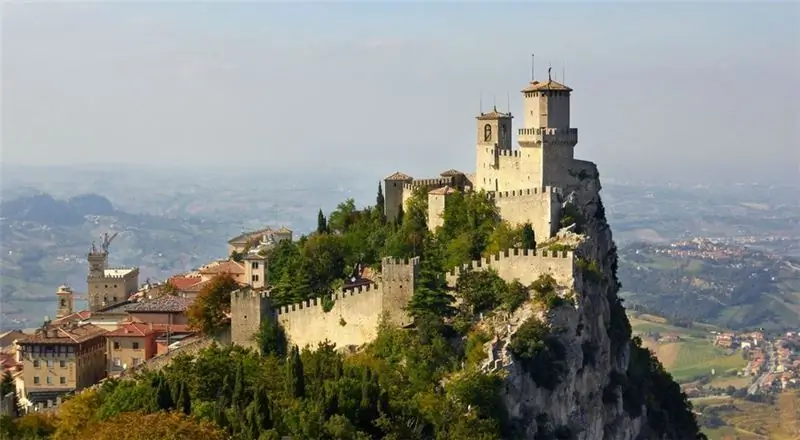
- San Marino: Where Is The Serene Republic Of?
- How to get to San Marino?
- Holidays in San Marino
- Souvenirs from San Marino
Not every vacationer has an idea where San Marino is located - a state for visiting which it is advisable to allocate the period from April to September (in August-September, on average, the air here warms up to a comfortable + 26˚C). Guests are treated to pizza, pasta, ravioli, fried rabbit, caramel dessert "kachyatello".
San Marino: Where Is The Serene Republic Of?
The location of the Republic of San Marino (area 60, 57 sq. Km, 80% of the territory is occupied by rock massifs), which is surrounded by the lands of Italy, is Southern Europe. San Marino borders on the Italian regions: in the southwest with the Marche, and in the east with Emilia Romagna.
The country occupies the southwestern slope of the three-domed mountain range of Monte Titano (it rises above the plain of the foothills of the Apennines), the foot of which has become a “haven” for several villages and castles. The Ausa and Marano flow through the territory of San Marino (these rivers flow into the Adriatic Sea).
The territory of San Marino is divided into Faetano, Fiorentino, Serraval, Montegiardino, Chiesanuova and other regional “castles” (there are 9 of them).
How to get to San Marino?
San Marino does not have its own air terminal, so first tourists will be offered to fly to Rimini (it will take 3 hours 35 minutes to fly here) or Bologna (tourists from Moscow will spend 3, 5 hours in flight; from Bologna to San Marino - 135 km). The 25 km distance separating Rimini from San Marino can be covered by bus in just 45 minutes (arrival point - car park in Piazzale Calcigni) or by car (you must take the SS72 state road).
Holidays in San Marino
Travelers should not ignore Serravalle (the attention of tourists deserves an ancient fortress, shopping arcades, a modern baseball and football stadium for 5000 visitors with plastic seats), Borgo Maggiore (famous for the Malatesta fortress (12th century), clock tower, helipad, square Piazza Grande, where fairs are often held), Domagnano (the ruins of the ancient fortress of Torracia, as well as the Church of San Michele Arcangelo and medieval-style houses are subject to inspection), Fiorentino (here you can see the ruins of the castle on the Monte Mogandzio hill, as well as relax in quiet and calm atmosphere of an unusually picturesque town), Chiesanuova (it is advisable to use a bicycle to move around the town; despite the fact that nothing has survived from the church of St. Giovanni Batista, once located here, tourists should find and get acquainted with historical monuments in Chiesanuova) …
The capital of the same name, San Marino, is of particular interest to tourists. Its main attractions are: the Basilica of San Marino (a neoclassical building with a portico with 8 Corinthian columns); Freedom Square; Palazzo Publiko (built in 1884-1894); the state museum (exhibits in the form of ancient coins, paintings of the 17th century, bronze statues and others are subject to inspection); Chesta towers (those who go inside will be offered to view about 700 exhibits of the museum of ancient weapons in the form of bows, crossbows, arrows, armor, etc.), Guaita (from it, tourists are offered to admire the picturesque San Marino views; this tower is captured on local coins, denomination 0.05 Euro) and Montale (famous for its prison, 8 m deep, which is called the "Tower Bottom"; Montale tower "flaunts" on the San Marino coin, denomination 1 euro cent).
Souvenirs from San Marino
In San Marino, you should get lace, gold coins, glass, wood and metal crafts, hand-painted ceramics, souvenir swords, knives and daggers, bed linen with the national symbols of the dwarf state, leather things, San Marino stamps, liqueur, a national waffle cake (the main ingredients are hazelnuts and chocolate cream).






